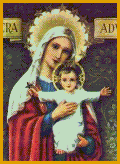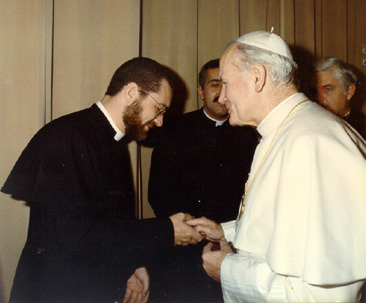 |
|
|
A Brief Description and History Our Lady of the Atonement Church is a Roman Catholic parish of the Archdiocese of San Antonio, and is the first of several “personal parishes” erected in the United States for the Anglican Use Liturgy. This parish has no affiliation with the so-called “Continuing Anglican Movement,” nor with any branch of the Episcopal or Anglican churches. Rather, its members, many of whom are converts from the Episcopal Church, have been granted permission to retain some elements of the Anglican liturgical heritage while being fully Roman Catholic. Throughout the world the Catholic Church has numerous liturgical rites all under the authority of the Roman Pontiff, and the Church has always taught that there can be legitimate diversity in unity. While the liturgy used at Our Lady of the Atonement Parish is not a separate Rite, it is the only approved variation of the Latin Rite in the United States.
Our Liturgical Heritage There are those who ask why Our Lady of the Atonement has a liturgical rite which is different from that which is found in other Catholic parishes. As Episcopalians, our liturgy was contained in the BOOK OF COMMON PRAYER. Much of what it contains is based upon the ancient liturgy of the Catholic Church, and was translated from the Latin into English in the sixteenth century. In the great Catholic ecclesiastical centers of England -- Salisbury, Hereford, York, Bangor and Lincoln -- distinct English liturgical uses existed prior to the Protestant separation. Because of a series of unfortunate historical circumstances, our spiritual forefathers had taken us out of communion with the Catholic Church; however, our way of worshipping and thinking retained much of the Catholic heritage. Now, with the establishment of the Pastoral Provision for an “Anglican Use” Common Identity within the Catholic Church, the historical precedent of a particularly English “Use” is once again a reality. Following the 1976 Episcopal Church Convention, a number of catholic-minded Episcopalians gathered together to explore ways to approach Rome, and the Society of St. Augustine was founded for this purpose. The San Antonio group formed St. Anthony’s Church. The laity contacted Fr. Phillips in Rhode Island, who came to San Antonio with his family in January of 1982. Prior to that, in 1979, a formal request and proposal was made to the Holy Father through the National Conference of Catholic Bishops. In June 1980, the Sacred Congregation for the Doctrine of the Faith issued the Holy Father’s “Pastoral Provision,” which granted the petitioners’ request: “... a common identity reflecting certain elements of their own heritage.” [Art. #84, “More Vatican II Documents” ed. Austin Flanney, O.P.]. These people, who formerly constituted St. Anthony’s Anglican Catholic Church, were received on the Solemnity of the Assumption of our Blessed Mother, 15 August 1983. In November of 1983, Fr. Phillips was appointed to serve on the Vatican’s Liturgical Commission for the Anglican Use headed by (then) Archbishop (now Cardinal) Vigilio Noé, of the Sacred Congregation for Sacraments and Divine Worship. This special Commission convened in Rome for the purpose of establishing the Anglican Use Liturgy. When the Holy Father, Pope John Paul II, and certain members of the Vatican Curia saw the great depth and beauty of our forms of worship, they judged that it was worthy to be incorporated into the official liturgical life of the Roman Catholic Church. The Order of Mass is approved for use in two forms: Rite I (in traditional English) and Rite II (in contemporary English). Also approved is the Psalter in two translations (traditional and contemporary), the Rite for Baptism, the Rite for Marriage, the Order for the Burial of the Dead, the Order for Morning Prayer, the Order for Evening Prayer, and the Great Litany. Certain saints’ days are observed in addition to those on the general Calendar. Membership In 1983, Our Lady of the Atonement Parish was established primarily for former Episcopalians who converted to the Catholic Church, and according to the Decree of Erection promulgated by Archbishop Patrick F. Flores, all former Episcopalians and other former members of the world-wide Anglican Communion who reside in this Archdiocese have a right to belong to the parish. In addition to these individuals from an Anglican background, we count converts from numerous other religious bodies as well as many life-long Roman Catholics as members. The parish is not territorial, but rather is a Personal Parish as outlined in Canon 518. The Archbishop has placed no restrictions on participation in the parish, since all Catholics may fulfill their religious obligations in any approved rite of the Catholic Church; therefore, all Catholics are welcome to take a full and active part in parish life and worship. The Cultural Milieu of the Parish Our Lady of the Atonement Church conforms completely to Catholic doctrine, Catholic practice, and Catholic moral teaching; however, its raison d’etre is primarily the liturgical use which belongs to it by right. Also, it maintains a particular cultural tradition which is expressed in such things as music, art, architecture, devotional life, preaching, language, literature, and even in its style of social ministry and personal interaction. With the long-standing practice of having married clergy in Churches and ecclesial communities other than in the Latin Rite of the Catholic Church, those parishioners whose background is in Anglicanism or in other forms of protestantism are accustomed to there being a place for the priest’s wife and children in the life and ministry of both the pastor and the parish. The Vision of the Parish Our Lady of the Atonement Church exists as a small witness to the legitimate diversity which is found within the unity of the Catholic Church. Its vision is the vision of the whole Church; namely, “to restore all things in Christ.” Its liturgical life, spirituality and other cultural characteristics provide a setting and atmosphere which many find conducive to their growth in, and expression of, the Faith. The ecumenical ramifications of this are important, in that the eternal verities are expressed in ways which are more familiar to those from certain backgrounds, more readily enabling them to enter into full communion with the Catholic Church. Also, as a testimony to the broader appeal of the liturgical and cultural life of the parish, there are those who, even though they do not have a non-Catholic background, find here a spiritual home and inspiration for the carrying out of their individual apostolates. These tools -- liturgy, spirituality, culture -— are used, then, in the carrying out of this vision: to welcome as many as possible into the full communion of the Church; to reconcile those who have, for whatever reason, wandered away from active life in the Church; to animate those who comprise the parish, so that they might show Christ and His redeeming love in the world. The School The Atonement Academy opened on 15 August 1994 guided by its Mission Statement, which says, “The spiritual, moral, intellectual, social and physical elements of the education which it offers are taught within the context of the Catholic Faith, and so a place of primary importance is given to helping each student develop a personal relationship with God, using those means provided by our Lord Jesus Christ ministering through the Church which He has founded.” Although at the time the school was built the parish was small, nonetheless the parishioners took seriously the importance of the place of education within the total ministry of the Church. Because it was founded as a school of a parish of the Pastoral Provision, it was always intended -- and indeed, it was necessary -- that it should reflect the vision of Our Lady of the Atonement Parish. Just as those who attend the parish do so by choice, knowing that it is part of the legitimate diversity which enriches our archdiocese, so those who consider enrolling their children in the school should do so for the same reason, choosing it not only for the academic education offered, but also for its liturgical, spiritual and cultural foundation which makes that diversity already present in the archdiocese a part of the archdiocesan school system. As the parish was established to be part of the archdiocese, so its
school was established to be part of the archdiocesan school system; however,
as the parish exists as part of the Pastoral Provision for the “Anglican
Use” Common Identity, so does its school. Any parent enrolling a child
in The Atonement Academy -- whether parishioner or not -- can be assured
that the religious instruction is, indeed, fully Catholic, and that the
religious practices are all within the legitimate and approved customs
of the Catholic Church.
Our Lady of the Atonement Catholic Church | More Information |











